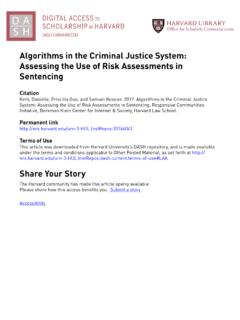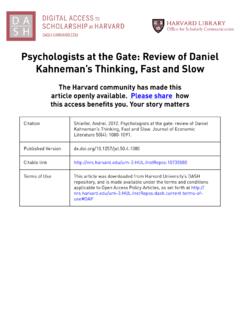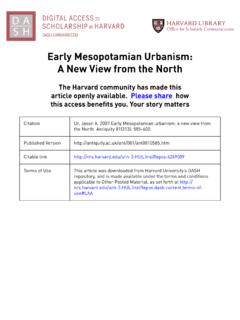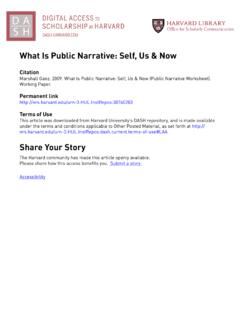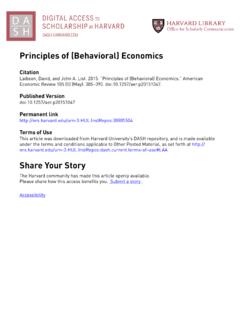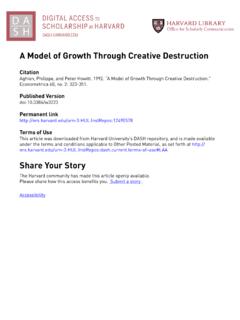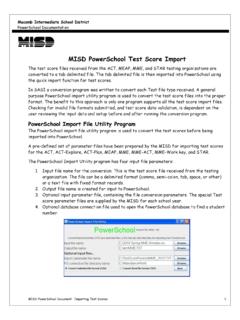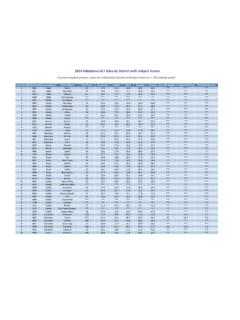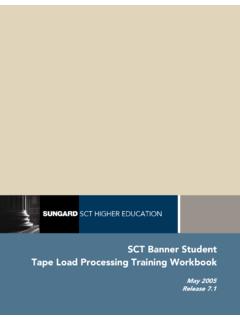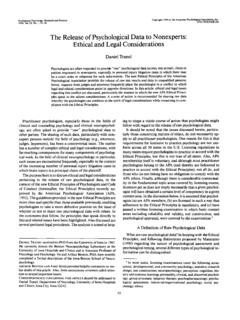Transcription of Descriptive Statistics for Modern Test Score Distributions ...
1 Descriptive Statistics for Modern TestScore Distributions : Skewness, Kurtosis,Discreteness, and Ceiling EffectsThe Harvard community has made thisarticle openly available. Please share howthis access benefits you. Your story mattersCitationHo, A. D., and C. C. Yu. 2014. Descriptive Statistics for ModernTest Score Distributions : Skewness, Kurtosis, Discreteness, andCeiling Effects. Educational and Psychological Measurement 75 (3)(September 15): 365 :27471533 Terms of UseThis article was downloaded from Harvard University s DASH repository, and is made available under the terms and conditionsapplicable to Open Access Policy Articles, as set forth at #OAPR unning head: Descriptive Statistics FOR Modern Score Distributions 1 Descriptive Statistics for Modern Test Score Distributions : Skewness, Kurtosis, Discreteness, and Ceiling Effects Andrew D.
2 Ho and Carol C. Yu Harvard Graduate School of Education Author Note Andrew D. Ho is an Associate Professor at the Harvard Graduate School of Education, 455 Gutman Library, 6 Appian Way, Cambridge, MA 02138; email: Carol C. Yu is a Research Associate at the Harvard Graduate School of Education, 407 Larsen Hall, 14 Appian Way, Cambridge, MA 02138; email: This research was supported by a grant from the Institute of Education Sciences (R305D110018). The opinions expressed are ours and do not represent views of the Institute or the Department of Education. We claim responsibility for any Statistics FOR Modern Score Distributions 2 Descriptive Statistics for Modern Test Score Distributions : Skewness, Kurtosis, Discreteness, and Ceiling Effects Abstract Many statistical analyses benefit from the assumption that unconditional or conditional Distributions are continuous and normal.
3 Over fifty years ago in this journal, Lord (1955) and Cook (1959) chronicled departures from normality in educational tests , and Micerri (1989) similarly showed that the normality assumption is met rarely in educational and psychological practice. In this paper, the authors extend these previous analyses to state-level educational test Score Distributions that are an increasingly common target of high-stakes analysis and interpretation. Among 504 scale- Score and raw- Score Distributions from state testing programs from recent years, non-normal Distributions are common and are often associated with particular state programs. The authors explain how scaling procedures from Item Response Theory lead to non-normal Distributions as well as unusual patterns of discreteness.
4 The authors recommend that distributional Descriptive Statistics be calculated routinely to inform model selection for large-scale test Score data , providing warnings in the form of sensitivity studies that compare baseline results to those from normalized Score scales. Descriptive Statistics FOR Modern Score Distributions 3 Descriptive Statistics for Modern Test Score Distributions : Skewness, Kurtosis, Discreteness, and Ceiling Effects Introduction Normality is a useful assumption in many modeling frameworks, including the general linear model, which is well known to assume normally distributed residuals, and structural equation modeling , where normal-theory-based maximum likelihood estimation is a common starting point ( , Bollen, 1989).
5 There is a vast literature that describes consequences of violating normality assumptions in various modeling frameworks and for their associated statistical tests . A similarly substantial literature has introduced alternative frameworks and tests that are robust or invariant to violations of normality assumptions. A classic, constrained example of such a topic is the sensitivity of the independent-samples t-test to normality assumptions ( , Boneau, 1960), where violations of normality may motivate a robust or nonparametric alternative ( , Mann & Whitney, 1947). An essential assumption that underlies this kind of research is that the degree of non-normality in real-world Distributions is sufficient to threaten the desired interpretation in which the researcher is most interested.
6 If most Distributions in a particular area of application are normal, then illustrating consequences of non-normality and motivating alternative frameworks may be interesting theoretically but of limited practical importance. To discount this possibility, researchers generally include a real-world example of non-normal data , or they at least simulate data from non-normal Distributions that share features with real-world data . Nonetheless, comprehensive reviews of the non-normality of data in educational and psychological applications are rare. Almost sixty years ago in this journal, Lord (1955) reviewed the skewness and kurtosis of 48 aptitude, admissions, and certification tests .
7 He found that test Score Distributions were generally negatively skewed and platykurtic. Cook (1959) replicated Lord s analysis with 50 classroom tests . Micceri (1989) gathered 440 Distributions , 176 of these from large-scale educational tests , and he described 29% of the 440 as moderately asymmetric and 31% of the 440 as extremely asymmetric. He also observed that all 440 of his Distributions were non-normal as indicated by repeated application of the Kolmogorov-Smirnov test ( .01). Descriptive Statistics FOR Modern Score Distributions 4 In this paper, we provide the first review that we have found of the Descriptive features of state-level educational test Score Distributions .
8 We are motivated by the increasing use of these data for both research and high-stakes inferences about students, teachers, administrators, schools, and policies. These data are often stored in longitudinal data structures ( , Department of Education, 2011) that laudably lower the barriers to the analysis of educational test Score data . However, as we demonstrate, these Distributions have features that can threaten conventional analyses and interpretations therefrom, and casual application of familiar parametric models may lead to unwarranted inferences. Such a statement is necessarily conditional on the model and the desired inferences. We take the Micerri (1989) finding for granted in our data : these Distributions are not normal.
9 At our state-level sample sizes, we can easily reject the null hypothesis that Distributions are normal, but this is hardly surprising. The important questions concern the magnitude of non-normality and the consequences for particular models and inferences. We address the question of magnitude in depth by presenting skewness, kurtosis, and discreteness indices for 504 raw and scale Score Distributions from state testing programs. Skewness and kurtosis are well established Descriptive Statistics for Distributions (Pearson, 1895) and are occasionally used as benchmarks for non-normality ( , Bulmer, 1979). We illustrate the consequences of non-normality only partially.
10 This is deliberate. A complete review of all possible analyses and consequences is impossible given space restrictions. Thus, our primary goal is to make the basic features of test Score Distributions easily describable and widely known. These features may guide simulation studies for future investigations of the consequences of violating model assumptions. Additionally, if variability in these features is considerable, this motivates researchers to use an arsenal of diverse methods to achieve their aims, with which they might manage tradeoffs between Type I and Type II errors, as well as bias and efficiency. We have two secondary goals. First, we provide illustrative examples of how these features can lead to consequential differences for model results, so that researchers fitting their own models to these data may better anticipate whether problems may arise.
